temo (Mdz27r)
This compound glyph doubles here to represent the verb temo, to descend. We could have carved the two black footprints by themselves, but we decided to leave the white, rectangular pyramid that the feet are descending, to make that action clearer.
Stephanie Wood
Footprint glyphs have a wide range of translations. In this collection, so far, we can attest to yauh, xo, pano, -pan, paina, temo, nemi, quetza, otli, iyaquic hualiloti, huallauh, tepal, tetepotztoca, totoco, otlatoca, -tihui, and the vowel "o." Other research (Herrera et al, 2005, 64) points to additional terms, including: choloa, tlaloa, totoyoa, eco, aci, quiza, maxalihui, centlacxitl, and xocpalli.
Stephanie Wood
c. 1541, but by 1553 at the latest
foot, feet, stepped pyramic, pirámide, pies, huellas, huella, footprint, footprints, steps, pasos, icximachiyotl, xocpalli, icxipamitl

temo, to descend, https://nahuatl.wired-humanities.org/content/temo
Codex Mendoza, folio 27 recto, https://digital.bodleian.ox.ac.uk/objects/2fea788e-2aa2-4f08-b6d9-648c00..., image 64 of 188.
Original manuscript is held by the Bodleian Libraries, University of Oxford, MS. Arch. Selden. A. 1; used here with the UK Creative Commons, “Attribution-NonCommercial-ShareAlike 3.0 License” (CC-BY-NC-SA 3.0)
